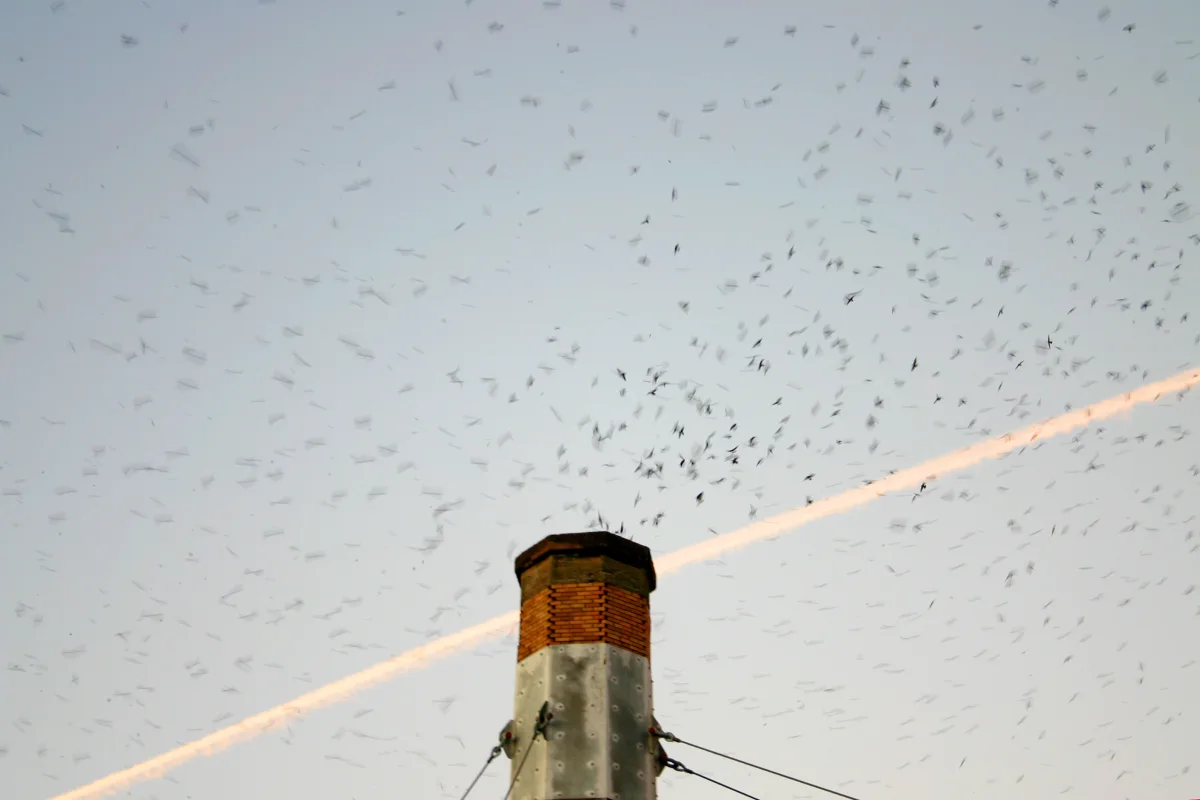
When I moved my family to the SW Oregon countryside of our Rogue Valley home region one autumn many years ago, we didn’t light a fire in the farmhouse’s very large fireplace that first year. As the heating bills rolled in for that drafty, rambling place, though, I swore I’d use a more economical heating source the next winter or some combination of sources.
Raising Babies
Come spring, we heard peeps and cheeps and squeaks emanating from inside the house’s living room, apparently from inside the fireplace! We didn’t yet know about Oregon’s fascinating relationship with the migratory bird called Vaux’s Swift—known best for its vertical flight––but a chimney sweep came to see us and initiated our education about this unusual bird species, its migratory patterns, and its special reliance on our beautiful state of Oregon and the Pacific Northwest for its survival.
The name is originally derived from the French surname, Vaux, pronounced “voe”, but in English the bird is more commonly referenced with the Latin pronunciation for voice, “vox”.
We learned we had baby Vaux’s Swift birds born into our two-story chimney, so we wouldn’t be cleaning it out and lighting any warm fires that winter. We needed to wait until after those babes grew up and left our house, left their tall chimney home, to join the annual spring Vaux’s Swift migration south to the warmer climes of Central and South America.
We enjoyed the raucous baby chatter inside the house all that spring and planned to have the chimney capped ahead of next autumn’s return. When next autumn came back around, though, the Vaux’s Swifts found their way back into our chimney before I could keep them out. (To be fair, I didn’t really try very hard and looked forward to the chirping chicks on the way.) We didn’t use the fireplace that year either, and thus began my internal struggle year-by-year to heat our home more cost-effectively through the winter or else offer up our big, old chimney as a short-term winter hostel for the migrating Vaux’s Swift population. More baby birds hatched and flew up and out that next spring and for several springtimes afterward.
The Dilemma
Eventually, we cap the chimney in time to prevent another visit, finally use the fireplace ourselves, and lower those heating bills, but we miss the visiting birds and their noisy springtime hatchlings ever after.
It turns out that Vaux’s Swifts are missing tall chimneys like ours in return. The Pacific Northwest, especially on the western side of the Oregon Cascades, is the primary overwinter roosting region for Vaux’s Swifts. Because they fly down into the hollows of dead old-growth trees, both coniferous and deciduous, losing more and more of that essential habitat to fire preventative thinning and other causes of deforestation, forces the birds to search out suitable old chimneys like ours––but capping or smooth-lining those chimneys closes off even that nesting alternative. My farmhouse dilemma was a microcosm of the larger-scale, intersectional dilemma between human-vs-wilderness habitats. I don’t have easy answers, only opinions. Still, I’m grateful I learned about these interesting, helpful, insect-eating birds, and I am thankful to be able to share that information here with you now, with the additional hope you will also share it with your family and friends.
What to Know
While Vaux’s Swifts can be spied diving into their seasonal nesting abodes throughout Oregon this time of year—between late August and all through September, sometimes even into mid-October––they primarily stick to the western side of the Cascade range for the hollow, old-growth trees and taller, old chimneys more readily found on the west side than on the east side.
It’s amazing to know Vaux’s Swifts are landing among us every fall when we learn that this nighttime roosting is just about the only time these tiny, mighty birds stop flying at all. Vaux’s Swifts spend so much of their lives in constant flight––eating, drinking, even sleeping while flying––that their little bird feet are adapted for clinging upright on vertical surfaces rather than for perching or walking like most other birds.
Vaux’s Swifts help keep Oregon’s problematic insect populations in check––including mosquitoes, beetles, wasps, and termites––and the birds’ presence here is a sign of a healthy ecosystem. Supporting the Vaux’s Swift population supports our own.
Happy news: the Vaux’s Swifts are arriving back earlier than usual this year, which may be due to the better air quality we’ve enjoyed in much of Oregon this summer than in summers past. Recognizable by their arced wingspan, which gives them the appearance of a boomerang and helps them maneuver rapidly, they are exciting birds to watch, but watching for them is a bit like waiting on a Perseids meteor shower: we have a short window of opportunity to see them, and we need to wait for them at the right time of the evening. Doing this in Oregon at this time of year, though, especially if you’re new to the state, is worth making an annual viewing event.
Vaux’s Swifts dive in tight, smooth swooping formations together in the evenings, spiraling like a cyclone above and then nearly straight down into their migration stays or their longer-stay overwinter roosts, all of which they share with many other Vaux’s Swifts at a time. You can make viewing this spectacular aerial display easier on impatient kids by visiting a known and protected roosting site; some are designated safe nesting locations for the Vaux’s Swifts, and others are simply good viewing spots in known neighborhoods where clusters of tall, old chimneys still remain unused and uncapped. The best time to watch for these bird populations is at the hour before sunset each evening.
Here are several places where you and your family can reliably view these bird neighbors returning to us this fall, mostly in September:
Chapman Elementary School, Portland
Riverside Community Church, Rainier
Umpqua Valley Arts Center, Roseburg
Hedrick Middle School, Medford
And for more information:
Vaux’s Happening Project, Monroe, WA
Vaux’s Swift Info at the National Park Service
Vaux’s Swift Info at Cornell Lab’s All About Birds
Vaux’s Swift Guide at the Audubon Society
Take this opportunity to present a teachable moment to your own children about migration and adaptation, as well as both the challenge and importance of preserving natural habitats. Don’t miss this opportunity to watch the Vaux’s Swift population coming back to their wintertime Oregon homes because though the Western Meadowlark is our Oregon state bird and widely viewable throughout the state during our warmer months, the Vaux’s Swifts are only briefly visible twice a year, and are one of the most popular species each September.

Traci NW (northwest) brings the SW region of Oregon closer to you from her generational hometown of Ashland in the Rogue Valley. She is a freelance writer and a licensed teacher with her MA from CU-Boulder (officially in Education, unofficially in skiing). The paperweight on her writing desk is a cat named Maya that does tricks. You can contact Traci directly at www.tracinw.com
